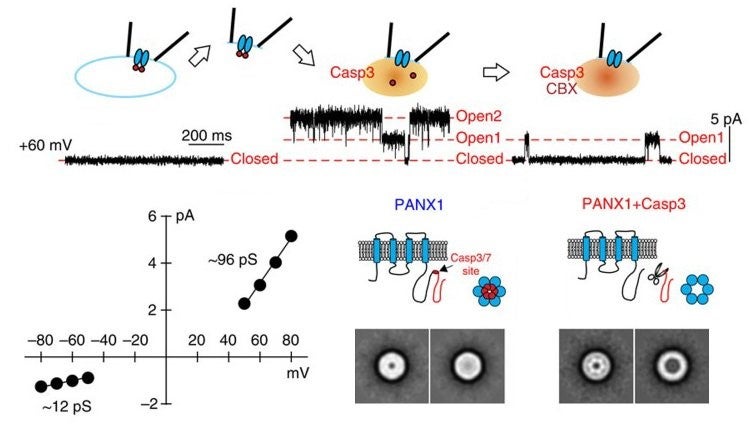Pannexin Channels: Reversible and Irreversible Mechanisms of Activation

Pannexin 1 (Panx1) channels
Pannexin 1 (Panx1) channels are widely-expressed membrane channels most renowned for their ability to mediate ATP release in service of paracrine purinergic signaling. Our laboratory has worked collaboratively with multiple groups at UVA to examine cellular and molecular mechanisms for activation of Panx1. We reconstituted a reversible α1-adrenoceptor-mediated Panx1 activation in vitro and uncovered molecular determinants required for the channel activation that underlies ATP release, regulation of vascular resistance and control of blood pressure. In the context of programmed cell death, we determined that caspase-mediated cleavage of the Panx1 C terminus removed an autoinhibitory domain to irreversibly activate the channel via a quantized mechanism. This novel mechanism entails progressive removal of subunit C-tails in the oligomeric Panx1 channels and leads to a stepwise increase in unitary conductance and open probability; the accompanying ATP release from apoptotic cells serves as a “find-me” signal for corpse clearance by phagocytes, and release of other metabolites provide a “good-bye” signal for enabling an anti-inflammatory environment. In recent work, we developed a proteolipos ome system incorporating purified Panx1 to verify that this channel is the pathway for metabolite flux, and to characterize the properties of large molecule permeants
Our ongoing work examines receptor-activated signaling mechanisms that regulate Panx1 activation, the molecular determinants of channel activation, and the atomic ion and large molecule permeation properties of the receptor-activated channel.
Select Publications
Review:
Revisiting multimodal activation and channel properties of Pannexin 1.Chiu YH, Schappe MS, Desai BN, Bayliss DA. J Gen Physiol. 2018 Jan 2;150(1):19-39. doi: 10.1085/jgp.201711888. Epub 2017 Dec 12. PMID: 29233884
Original Research:
ATP and large signaling metabolites flux through caspase-activated Pannexin 1 channels. Narahari AK, Kreutzberger AJ, Gaete PS, Chiu YH, Leonhardt SA, Medina CB, Jin X, Oleniacz PW, Kiessling V, Barrett PQ, Ravichandran KS, Yeager M, Contreras JE, Tamm LK, Bayliss DA. Elife. 2021 Jan 7;10:e64787. doi: 10.7554/eLife.64787. PMID: 33410749
A quantized mechanism for activation of pannexin channels. Chiu YH, Jin X, Medina CB, Leonhardt SA, Kiessling V, Bennett BC, Shu S, Tamm LK, Yeager M, Ravichandran KS, Bayliss DA. Nat Commun. 2017 Jan 30;8:14324. doi: 10.1038/ncomms14324. PMID: 28134257
Hematopoietic pannexin 1 function is critical for neuropathic pain. Weaver JL, Arandjelovic S, Brown G, K Mendu S, S Schappe M, Buckley MW, Chiu YH, Shu S, Kim JK, Chung J, Krupa J, Jevtovic-Todorovic V, Desai BN, Ravichandran KS, Bayliss DA. Sci Rep. 2017 Feb 14;7:42550. doi: 10.1038/srep42550. PMID: 28195232 Free PMC article.
Pannexin 1 channels mediate ‘find-me’ signal release and membrane permeability during apoptosis. Chekeni FB, Elliott MR, Sandilos JK, Walk SF, Kinchen JM, Lazarowski ER, Armstrong AJ, Penuela S, Laird DW, Salvesen GS, Isakson BE, Bayliss DA, Ravichandran KS. Nature. 2010 Oct 14;467(7317):863-7. doi: 10.1038/nature09413. PMID: 20944749
https://www.ncbi.nlm.nih.gov/sites/myncbi/douglas.bayliss.1/collections/48218425/public/
